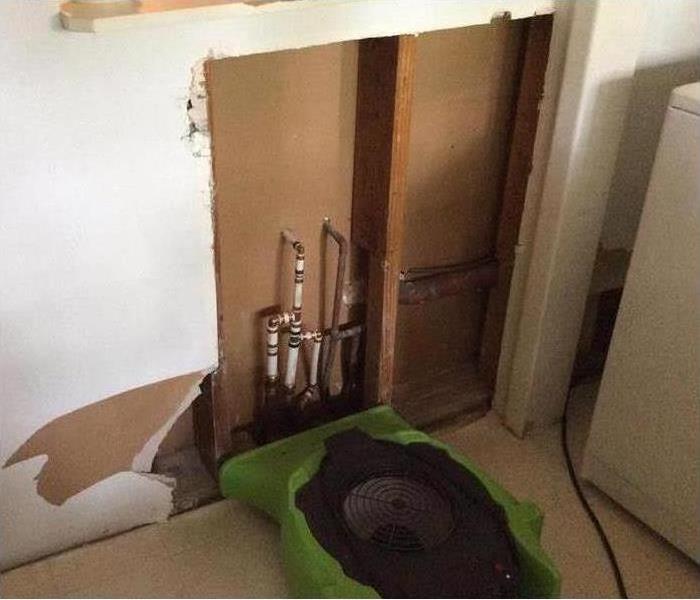Recent Mold Remediation Posts
Signs of Mold
2/8/2024 (Permalink)
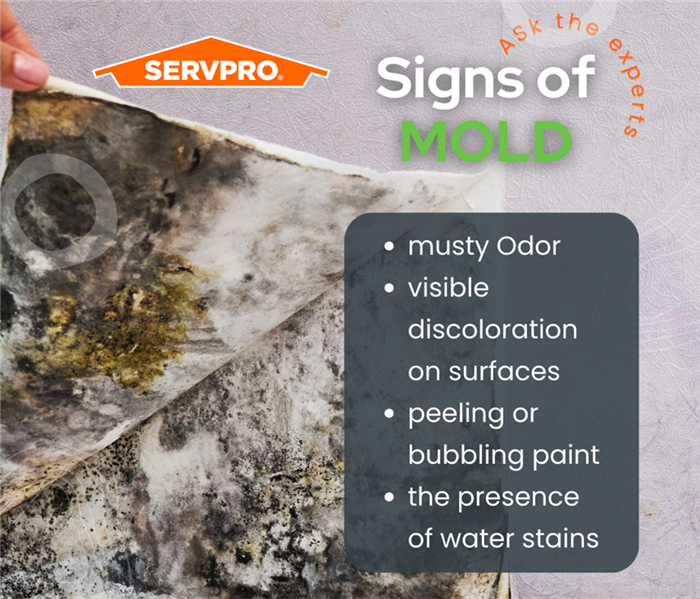 Here are a few signs that you might have mold.
Here are a few signs that you might have mold.
Are you at risk of mold resulting from recent water damage?
When water damage occurs, it is crucial to address the issue promptly. Water damage can lead to the growth and spread of mold in various areas of a building. Mold thrives in moist environments and can quickly develop after a water leak or flood. It can be found on walls, ceilings, floors, and even in hidden places such as behind wallpaper or inside insulation.
Here are a few of the signs that indicate the presence of mold resulting from water damage: a musty odor, visible discoloration on surfaces, peeling or bubbling paint, and the presence of water stains. If you notice any of these signs, it is essential to take immediate action to identify and address the source of the water damage and remove the mold.
Frequently Asked Questions about Mold
11/29/2022 (Permalink)
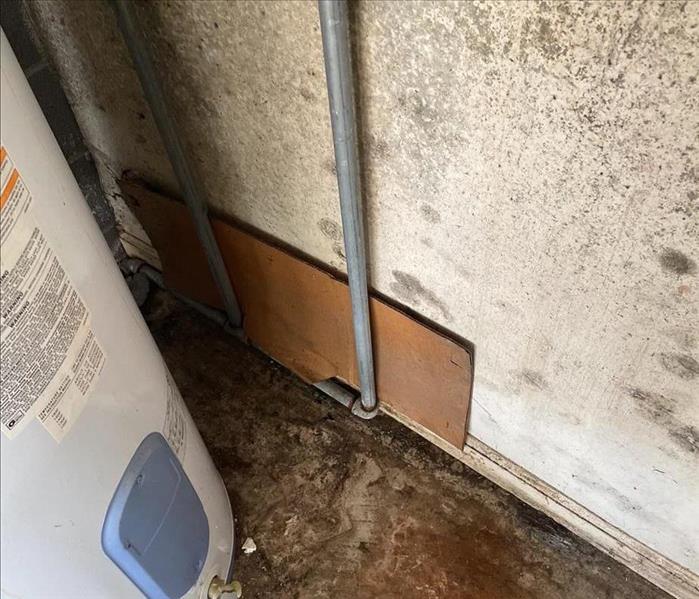 Mold is never wholly gone; it just goes dormant as invisible spores in your environment. If mold finds a combination of organic matter and moisture to
Mold is never wholly gone; it just goes dormant as invisible spores in your environment. If mold finds a combination of organic matter and moisture to
Mold Growth: Frequently Asked Questions
Mold may be disgusting and a danger to your home, but do you truly understand what mold is? Let’s take a look at a few frequently asked questions about mold, and what you can do to prevent its outbreak in your Volusia County home.
What Is Mold?
Mold is a fungus that can take root in your home and proliferate, causing unsightly stains and potential health effects. Once mold sinks in deep it can be hard to get rid of.
What Causes Mold to Grow?
Mold growth is primarily caused by excess moisture in your home environment. You can frequently find it in places in your home that have suffered water damage. Factors that contribute to mold growth include:
- High humidity environments
- Water damage from flooding or leaking
- Broken and damaged pipes
- Condensation from malfunctioning appliances
Is Mold Different from Mildew?
While both mold and mildew are fungal growths, they’re not the same thing. You can generally tell them apart by texture; where mildew tends to be soft and powdery and will flake off to the touch, mold tends to be a fuzzier growth with a thicker texture.
How Can I Get Rid of Mold?
Mold remediation is a complex process that begins with eliminating the source of the mold. This means identifying where your water damage is coming from and repairing your leaking roof or a broken appliance, or using a dehumidifier to remove moisture from the air. Cleanup can require disposing of mold-infested items and scrubbing others with baking soda and vinegar or harsher chemical solutions.
Once the Mold Is Gone, Will It Come Back?
It can. Mold is never wholly gone; it just goes dormant as invisible spores in your environment. If mold finds a combination of organic matter and moisture to feed on, then it can take root again and begin to grow. It’s best to remain vigilant and continuously seek to eradicate mold sources from your environment.
How To Get Rid of Mold in Your House
11/29/2022 (Permalink)
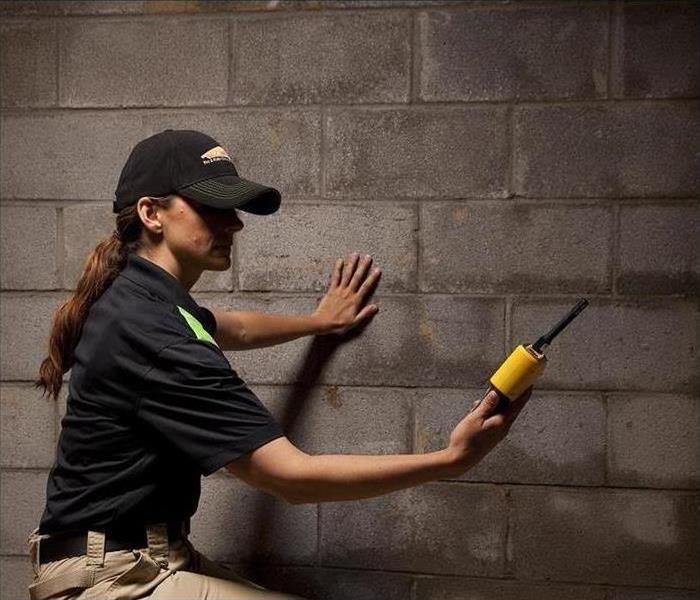 You can count on our expertise in house mold removal and get assurance that it won’t be happening in the future.
You can count on our expertise in house mold removal and get assurance that it won’t be happening in the future.
Black mold can be a nasty, dangerous, and persistent problem for homeowners. It can spread quickly throughout your house and it's tough to get rid of without the proper tools for house mold removal. Moreover, it can easily affect the health of the people living in the house. In 2004, the Institute of Medicine (IOM) concluded that there was enough evidence to associate indoor mold exposure with health effects in otherwise healthy individuals.
Black mold is very dangerous and the sooner you get rid of it, the better. Follow these expert tips to prevent further damage to your house.
Remove any mold from the carpet.
Many people think that mold only grows on surfaces, but this isn't true. It can spread under your carpet and damage it as well. If you find any signs of black mold underneath your carpet, take off all the flooring to check every inch for further signs of growth. This way you will prevent unnecessary damage to your house later. While doing this, make sure to put on protective gear like gloves, goggles, etc.
Seal the damaged spot from the rest of the house.
If there are cracks or holes in between where mold can grow, cover everything with plastic sheeting. Make sure no air gets inside while you're applying this method because black mold will spread quickly if conditions are right.
Open up moldy walls and ceilings.
If you're going to open up a wall or ceiling, make sure that the space is well-ventilated. If not, there's a risk mold may grow back since it thrives in small spaces with low oxygen levels. Remove any wet insulation around water damage and use fans as much as possible. Don't allow moisture from your home to get in contact with the moldy area.
All moldy items should be placed in a bag.
Put all moldy items in a plastic bag and seal them tightly. This way you will prevent the spread of black mold to other parts of your house, especially if there are still signs that this problem has not been completely resolved yet.
Thoroughly scrub, clean, and repair affected areas.
When you're done, make sure to clean and scrub all affected areas. After doing this, fix any damaged surfaces if necessary, and don't forget about cracks or holes where mold can still grow.
Moldy areas should be resealed after they've had a chance to dry.
When you're done cleaning and repairing, make sure to reseal the affected areas. This will prevent the possible return of mold by keeping your house well-ventilated and dry at all times.
Schedule a mold removal service!
Controlling dampness is the most effective approach to prevent mold. The important thing is to be careful and follow every step carefully if there's a risk that black mold may grow back in certain parts of your house. If you're not sure how to properly get rid of black mold, consider hiring a professional mold removal service. You can count on our expertise in house mold removal and get assurance that it won’t be happening in the future.
How To Get Rid of Mold on Your Ceiling
11/29/2022 (Permalink)
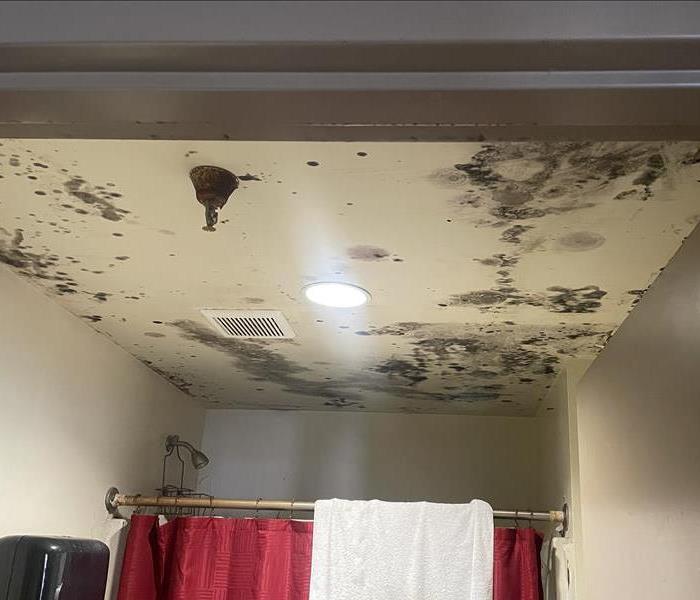 If you are not sure how to clean roof and ceiling mold, you should contact a professional.
If you are not sure how to clean roof and ceiling mold, you should contact a professional.
Mold can grow in your home either indoors or outdoors, some are even hidden in areas you don’t expect. When it grows on your ceiling or roof shingles, it can cause serious damage. So, when this happens, you should hire a mold removal service as soon as it is discovered. The longer you wait, the more damage it can cause. You also need to be careful to use the right tools when doing house mold removal on your roof and ceiling. Otherwise, you can risk making the roof more susceptible to damage.
How to clean mold off the ceiling?
One of the first things you need to do when you are trying to clean roof mold from your ceiling is to find out if it is a type of black mold or a different type of mold. The reason for this is that not all molds can be cleaned off surfaces without causing damage to those surfaces. Black mold is one of the mold types that can cause damage to the surface, so you need to be careful when cleaning it off the ceiling or roof shingles.
Most types of molds can be removed with hot water and soap mix. You need to spray it on the mold and let it sit for several minutes. When you come back, you need to scrub the mold off with a brush. You can buy a brush made specifically for scrubbing off roof mold at your local home improvement store. Then, you should spray the surface with the soap and water solution again and rinse it off with a hose. This process, however, cannot kill the spores. Hiring a professional to do the house mold removal will ensure that the spores are totally removed.
How to remove mold from roof shingles?
If you have mold on your roof shingles, the first thing you need to do is make sure that there is as much air as possible moving through the roof, so the mold does not grow any further. The easiest way to do this is to remove the moldy shingles and replace them with new ones. After the moldy shingles are replaced, you should make sure that any air moving through the roof has a way to leave the roof, so the mold does not grow back.
The next thing you need to do is find a way to prevent any future growth of mold on the roof. To do this, you need to have a fast and efficient cleaning system for your roof. Having a good quality gutter system will also help you to keep mold from growing on your roof.
Conclusion
If you are not sure how to clean roof and ceiling mold, you should contact a professional. Schedule a mold removal service appointment to ensure you receive expert roof and ceiling mold removal.
How to Clean Mold Off Exterior Door?
1/18/2022 (Permalink)
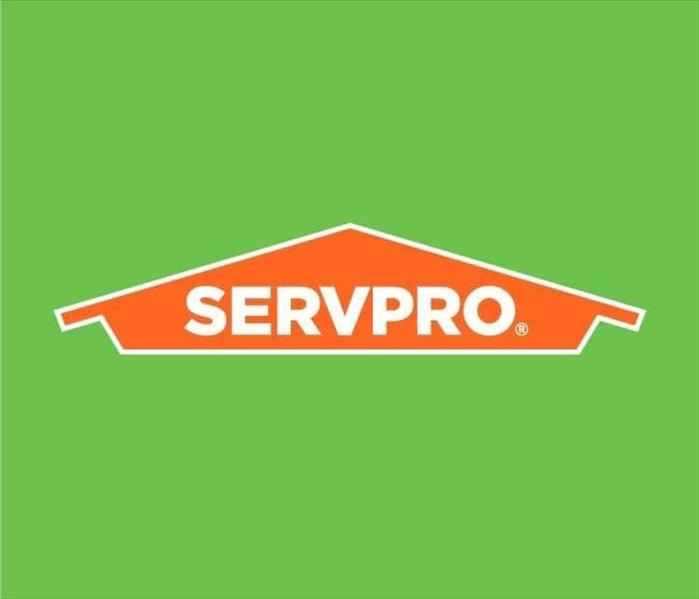 If you need extensive help with the mold growth in your exterior doors, nothing can beat professional mold restoration services!
If you need extensive help with the mold growth in your exterior doors, nothing can beat professional mold restoration services!
Mold is a type of fungus and can grow on surfaces and materials. Mold will not only leave your favorite shirt with an unpleasant odor, but it can also leave surfaces unsightly – especially on exterior doors. In some cases, cleaning mold off exterior doors will require some elbow grease, but the result is worth it.
Here are some tips to help you remove this pesky intruder from your home or office space.
Identify the material of your door.
If it is made of wood, you will want to use a mold removal product specifically designed for wood surfaces. Products like this can easily be found at most hardware stores. If your door is made of plastic or vinyl, you can use a general all-purpose cleaner to get rid of the mold.
Use a scrub brush to apply your cleaner directly onto the surface where you see visible traces of mold and allow it to sit for five minutes before rinsing it off with warm water. Be sure to wear protective gloves when working with cleaning products! You can also take this time to inspect other areas around your door for potential mold growth.
Use water and vinegar solution.
Mix equal parts of white vinegar and hot water in a spray bottle. Apply this mixture to all areas where you see mold with either paper towels or an old rag, then wipe it away until the area is clean. This solution is less harsh than using a commercial cleaner, but it may take some extra time to get the job done.
Use chlorine bleach solution.
Create a 50/50 mix of chlorine bleach and warm water inside another spray bottle. Apply this mixture to any areas where you see mold but take care not to get it on any surfaces that will be affected by the bleach. Let the solution sit for a few minutes before rinsing it off with warm water. If your door is made of metal, you can also use a wire brush to scrub away any mold that is clinging to the surface.
Get a cleaning professional involved.
If the mold on your door is extensive, or if you are uncomfortable with any of the methods listed above, it may be best to look for mold remediation near me. When it comes to professional mold restoration, you are guaranteed to have the experience and equipment necessary to get rid of even the most stubborn strains of mold.
Let everything dry and prevent moisture buildup.
After you have removed all the molds from your door, be sure to allow it to dry completely before closing it again. Moisture is the key ingredient for mold growth, so take measures to prevent it from coming back. You can place a fan near the door to circulate air, or you can use a dehumidifier to keep the environment dry.
Conclusion
Mold is never a welcome sight, but luckily it can be easily removed with some simple tools and products. If you need assistance with the process, look for expert mold remediation near me. Nothing can beat professional mold restoration services!
The Lingering Effect
12/20/2018 (Permalink)
Mold. It is usually never foreseeable and never found until one day you open up that back storage closet that you NEVER go in and it smells a little strange. Moving things around you find it, and then you call us.
However, there are cases when a mold problem should be foreseeable and can hopefully be taken care of before it is even a problem. When does this occur?
During floods or water damages.
You should always be aware that anytime you have had flood damage to your home or place of business it is likely for mold growth to occur in that area. In fact, it's more than likely. That is why you always hire a water damage restoration specialist (we know a good one) to deal with flood or water damage. SERVPRO will make sure that you are at the least possible risk for any lingering mold growth.
Give us a call for a FREE mold inspection: (386) 574-0864.
Preventative Measures Against Mold Growth In Your Home
12/20/2018 (Permalink)
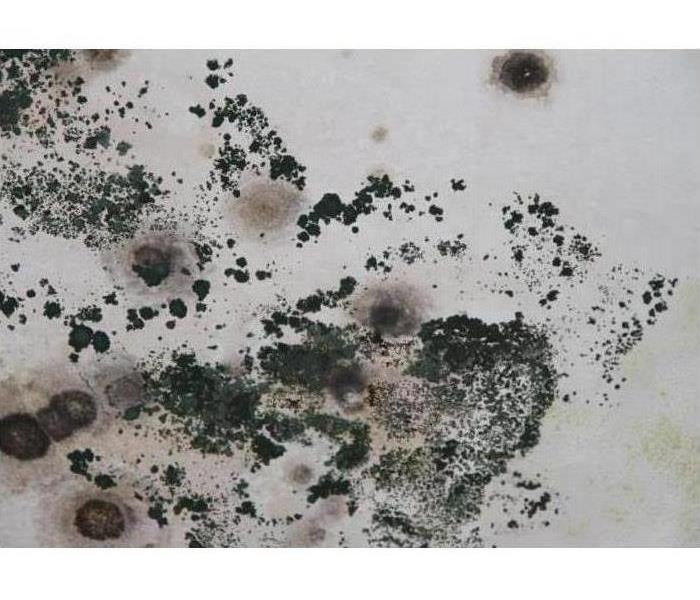
Did you know that mold spores occur naturally in our environment? Especially if you live here in Central Florida, mold spores almost always exist in some form due to our high humidity levels. However, this does not equate to a mold problem in your home, something that can be maintained through a few easy steps we will share with you below! - Avoid long-term leaks: this one may seem obvious, but so many times we can make a temporary "quick fix" to a problem that isn't going away. Leaks are the leading cause for mold in a home so always make sure when you discover a leak that you get it taken care of right away.
- Mold loves wood: that's right, wood becomes an easy target for mold growth in the right moisture setting. That's why it is always good to use plastic or metal containers or shelving in places where high moisture levels can occur, such as a garage or a basement.
- Limit moisture in kitchens and bathrooms: Always try to make sure and vent an area that contains moisture. After you shower, turn on the vent in the bathroom for at least 20 minutes. Also, you can turn on the vents when cooking on a stove as well.
- Inspect your air conditioning unit: Finally, make sure to complete a yearly inspection of your air conditioning unit. Mold spores can get trapped and build up in certain areas causing it to expand.
Remembering these tips will not guarantee that you will never have a mold problem occur. However, it will help reduce the risk!
Hidden Mold - Inspection Process
12/10/2018 (Permalink)
 Hidden mold in a home
Hidden mold in a home
Do you have an odor you can't identify? Do you see dark staining or visible mold? If so, let us come out and determine if you have a mold problem that needs to be addressed.
Microscopic mold spores naturally occur almost everywhere, both outdoors and indoors. This makes it impossible to remove all mold from a home or business. Therefore, mold remediation reduces the mold spore count back to its natural or baseline level. Some restoration businesses advertise “mold removal” and even guarantee to remove all mold, which is a fallacy. Consider the following mold facts:
- Mold is present almost everywhere, indoors and outdoors.
- Mold spores are microscopic and float along in the air and may enter your home through windows, doors, or AC/heating systems or even hitch a ride indoors on your clothing or a pet.
- Mold spores thrive on moisture. Mold spores can quickly grow into colonies when exposed to water. These colonies may produce allergens and irritants.
- Before mold remediation can begin, any sources of water or moisture must be addressed. Otherwise, the mold may return.
- Mold often produces a strong, musty odor and can lead you to possible mold problem areas.
- Even higher-than-normal indoor humidity can support mold growth. Keep indoor humidity below 45 percent.
If your home or business has a mold problem, we can inspect and assess your property and use our specialized training, equipment, and expertise to remediate your mold infestation.
If You See Signs of Mold, Call Us Today – 386-574-0864
Testing For Mold In Your Central Florida Home?
10/5/2018 (Permalink)
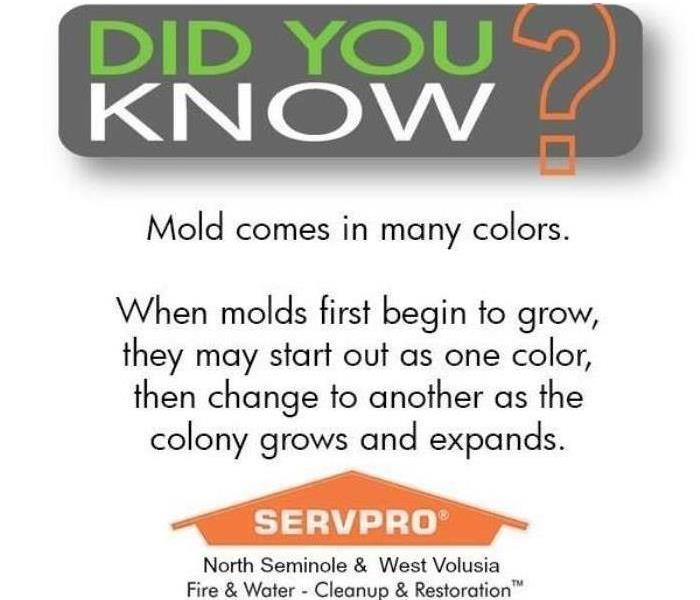 Mold is hard to handle on your own. Let the professionals at SERVPRO combat the task.
Mold is hard to handle on your own. Let the professionals at SERVPRO combat the task.
When you should test for mold:
- Following flood damage
- Once a leak is found
- When you notice stains that you cannot explain
- When you smell mold, but cannot see it
- If someone in your home develops a medical condition that cannot be explained
The Process:
- Call for a mold inspection if you see or smell mold, or if you are experiencing health problems, most notably, difficulty breathing.
- A visual assessment can help determine where mold is located. Air samples will be taken and tested for mold spores. Once testing is complete, a report will be issued with the findings.
- If test result prove that there is in fact mold present it is important to call a mold remediation specialist, such as SERVPRO, to take care of the job. During mold remediation, professionals will use protective clothing (including masks and gloves) and the proper equipment to ensure the mold does not spread.
- Finally, air samples will be taken again once mold has been removed. A new report will be issued.
Got Mold?
9/10/2018 (Permalink)
 Mold was found down near the baseboards in this home.
Mold was found down near the baseboards in this home.
What's that musty odor? Where did this spot on the ceiling come from? Has the corner of that wall always looked like that?
If any of the above questions make you think about your home, it's time to give SERVPRO of West Volusia County a call.
The bad news: If you have ever asked or thought any of the above questions, you may be dealing with a mold issue in your home.
The good news: We are experts in mold remediation! Our crew would be happy to come out and inspect your home and the area of concern to see what you may be dealing with - at no cost to you, of course.
Mold in your home can be scary...In some cases it may even mean health concerns for your family. But don't worry, SERVPRO of West Volusia County is here to serve you and help get your life back to normal and your home mold free!
Give us a call today: 386-574-0864
Do I Have A Mold Issue?
12/20/2017 (Permalink)
 Mold can spread through a home in as little as 48 hours.
Mold can spread through a home in as little as 48 hours.
Microscopic mold spores naturally occur almost everywhere, both outdoors and indoors. This makes it impossible to remove all mold from a home or business. Therefore, mold remediation reduces the mold spore count back to its natural or baseline level. Some restoration businesses advertise “mold removal” and even guarantee to remove all mold, which is a fallacy. Consider the following mold facts:
- Mold is present almost everywhere, indoors and outdoors.
- Mold spores are microscopic and float along in the air and may enter your home through windows, doors, or AC/heating systems or even hitch a ride indoors on your clothing or a pet.
- Mold spores thrive on moisture. Mold spores can quickly grow into colonies when exposed to water. These colonies may produce allergens and irritants.
- Before mold remediation can begin, any sources of water or moisture must be addressed. Otherwise, the mold may return.
- Mold often produces a strong, musty odor and can lead you to possible mold problem areas.
- Even higher-than-normal indoor humidity can support mold growth. Keep indoor humidity below 45 percent.
If you think your home or business has a mold problem, we can inspect and assess your property and use our specialized training, equipment, and expertise to remediate your issue.
If you see signs of mold, have a musty odor or just want some peace of mind, call us today at (386) 574-0864.





 24/7 Emergency Service
24/7 Emergency Service





